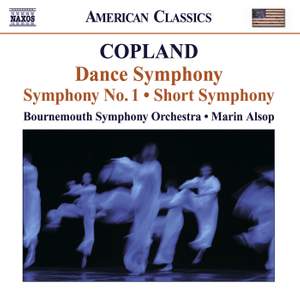Copland - Symphony No. 1
Bournemouth Symphony Orchestra, Marin Alsop
Under Marin Alsop's incisive direction, the Bournemouth musicians perform all three works with just the right blend of power and finesse, and negotiate their sometimes extremely complex rhythms... — More…
CD
$13.25Downloads
What are FLAC and MP3?Contents
Copland: Symphony No. 1
Work length25:28
$6.00
$7.75
$10.50
- Bournemouth Symphony Orchestra
- Marin Alsop
I. Prelude. Andante
Track length6:52
$1.00
$1.30
$1.75
II. Scherzo. Molto allegro
Track length8:02
$2.00
$2.60
$3.50
III. Finale. Lento
Track length10:34
$3.00
$3.85
$5.25
Copland: Symphony No. 2 "Short Symphony"
Work length15:35
$3.00
$3.90
$5.25
- Bournemouth Symphony Orchestra
- Marin Alsop
I. Quarter Note = 144
Track length4:20
$1.00
$1.30
$1.75
II. Half Note = 44
Track length5:08
$1.00
$1.30
$1.75
III. Quarter Note = 144
Track length6:07
$1.00
$1.30
$1.75
Copland: Dance Symphony
Work length17:24
$3.00
$3.90
$5.25
- Bournemouth Symphony Orchestra
- Marin Alsop
I. Lento - Molto allegro "Dance of the Adolescent"
Track length6:56
$1.00
$1.30
$1.75
II. Andante moderato "Dance of the Girl Who Moves As If in a Dream"
Track length5:12
$1.00
$1.30
$1.75
III. Allegro vivo "Dance of Mockery"
Track length5:16
$1.00
$1.30
$1.75





